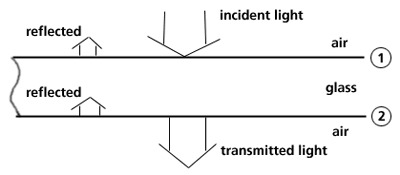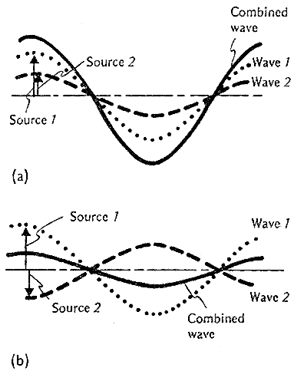Color, Thin Films, and Interference
The colors of nature are all around us and are produced by different aspects of the interaction of light with matter. The most common is light interacting with colored pigments. The reflection and absorption of light on a red ball produces a red color due to the pigments in the paint. Another interaction is the scattering of light from particles typically smaller than the wavelengths of visible light (smaller than 400 nanometers, for example).
The blue color on a clear day is due to the preferential scattering of short wavelength (λ) blue light compared to the scattering of the longer wavelength (λ) of red light. This preferential scattering of short wavelengths is due to Rayleigh scattering which is proportional to the reciprocal of the wavelength to the 4th power (scattering ~ λ-4). Rayleigh proposed the blue of the sky is due to the gases in the atmosphere (nitrogen and oxygen), that is, to the scattering of light by individual molecules. Earlier (1869), John Tyndall had demonstrated that fine dust particles (small but larger than the wavelengths of visible light) could lead to preferential scattering of blue compared to red light.
In birds, preferential scattering leads to blue colors (not the red colors which are due to pigments). The blue colored scattering units are small particles such as air cavities or keratin particles overlying a dark layer. The blue color occurs when the light not scattered by the particles is absorbed in the dark layer. The blue color is a structural color, often referred to as a Tyndall blue structural color.
In this section, we are interested in a third color-producing phenomenon in addition to pigments and structural phenomena. It is called interference and is due to waves of light interacting with each other to produce constructive reinforcement or destructive cancellation of the waves. Interference phenomena produces the colors seen on oil slicks in water or in the colors of bubbles or in the colors seen in thin silicon oxide layers on silicon. The oils and silicon oxides are in themselves colorless but when present as a thin layer (film) on another material produce colors. These colors are referred to as thin film interference colors.
Thin films as well as the feathers on a peacock produce iridescent colors, where iridescent means showing many colors (rainbow). These iridescent colors change when the viewing angle is changed. This differs from colors due to pigments or preferential scattering where the color does not change with changes in the viewing direction. The blue of a blue jay's feather remains blue as you rotate it whereas the peacock tail-spot colors shift with changes in viewing angle.
Thomas Young in 1801 described thin film interference colors as the interaction of light waves reflected from the top surface of a thin film with those which penetrate the film and are reflected from the back surface of the film. To understand how colors are produced by reflected light from the top and bottom sides of a film requires a discussion of wave optics.
Reflection of light waves occurs whenever the light penetrates from one medium into another. Reflection occurs at the boundary or

Figure 1. Light in air incident on a glass layer penetrates through the glass forming a transmitted light beam with light reflected from the top (surface 1) and bottom layer (surface 2). About 4% of the incident light is reflected at the air/glass boundary so that the transmitted light intensity is 92% of the incident light intensity taking into account reflection losses from the two boundaries.
interface between two transparent materials (air and glass or oil and water, for example) with the amount of reflection dependent on the differences in refractive indices between the two materials.
Light incident on a transparent thin film produces two reflected beams: one from the front and one from the back surface. These two beams can interfere with each other to enhance or reduce the light intensity. Figure 2 gives a pictorial representation of the interference produced by waves of the same wavelength (λ) from two sources either a) in phase or b) a half-wavelength (λ/2) out of phase.

Figure 2. (a) Two sources close to each other and oscillating in phase emit two waves that are everywhere in phase, and thus interfere constructively. (b) Two close, out-of-phase sources emit waves that interfere destructively everywhere. (taken from "Seeing the Light" by D. Falk, D. Brill, and D. Stork (J. Wiley, New York, 1986).)
Now it is a general property of wave reflection, whether mechanical or electrical in its mechanism, that when the two rays are reflected under these different conditions there is a reversal of phase of one ray with respect to the other as compared with the mere consideration of distance traveled would indicate."
If the phase difference between beams reflected at the front and back surfaces equals one full wavelength (or multiples thereof) that wavelength - color - will be reinforced. The intensities of the reflected light from other wavelengths traveling the same path in the film are either weakened or, for half-λ phase difference where crest meets trough, eliminated. Figure 3 shows that the light path distance in the film depends on the angle at which the light strikes the surface (and, of course, on the film thickness).

Figure 3. Two beams of light, 1 and 2, incident on a glass film of thickness t at angles of incidence θ1 and 2 have different path lengths (2 t cosθ) when reflected off the back surface.
A monochromatic (single color and thus single wavelength, λ) light beam incident on a thin film can have the reflected beam either reinforced or diminished depending on the phase difference and hence angle of incidence and film thickness. This is the reason why iridescence colors (such as the colors on a peacock feather) shift when the angle of incidence changes.
The path length differences (often called phase difference) of integral wavelengths or half-wavelengths required to produce reinforcement or cancellation depends on the thin film material and the boundaries. Light going from air to glass (low refractive index to high refractive index) has a phase-change equivalent to one-half wavelength in the reflected beam. This phase change in the reflected beam does not occur going from glass to air (high to low refractive index). If light is incident on a thin film in air, and the path difference is an integral number of wavelengths the reflected beams are not in phase but one-half wavelength out of phase due to phase changes at the boundary.
If the thin film is tapered then the path lengths will differ across the film and will vary from integral to half-wavelengths across the film. This produces a series of parallel fringes on a tapered film. You can produce these fringes by inserting a piece of paper at the edge of a pair of microscope slides.
If a slightly curved (convex) lens is placed on a plane glass surface (microscope slide) a series of light and dark (or colored) concentric circles is seen in reflected light. These are known as Newton's rings (after Isaac Newton); their presence is used to test the "flatness" of optical flats pressed together.
Interference effects are found in the iridescence of oil slicks on water and in soap bubbles. A representative film thickness is 500 nm or 0.5 microns for interference effects in visible light. If the films are much thicker, the iridescence vanishes. Where the film is too thick, the different colors that all interfere constructively overlap and produce a white color.
Want to try activities highlighting these principles? Click on the name of this activity to find an easy, hands-on experiment:









